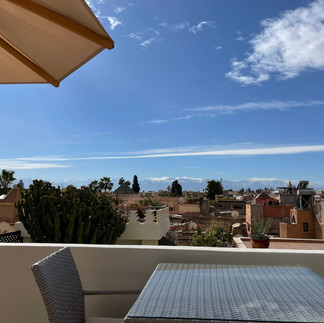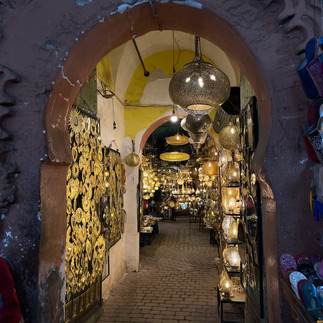Olivia Amplified


Last week, my mom and I traveled to Lisbon, Portugal and Marrakech, Morocco for my spring break!
Before going to Marrakech, I knew very little about the country’s government and society. I was aware of its strong Muslim influence and had a general understanding of their gender dynamics. However, engaging with locals and experiencing the culture completely deepened my understanding of Morocco’s legal social landscape.
One of the most interesting things I learned during my trip was how much the people I spoke with admired their leader, King Mohammed VI. I began researching his impact on Moroccan society and became particularly interested about his contributions to the realm of gender rights and family law.
Morocco is a North African constitutional monarchy with a complex legal system that blends Islamic law (Sharia), civil law, and customary practices. Historically, Moroccan society has been shaped by patriarchal norms, religious traditions, and a monarchy that has played a central role in shaping legal and social reforms. The country transitioned from an authoritarian rule under King Hassan II (r. 1961–1999) to a more democratized governance under King Mohammed VI, who ascended the throne in 1999.
One of King Mohammed’s most significant legal advancements was the reform of the Moudawana (Family Code) in 2004. The family code reforms sought to modernize and equalize gender rights in marriage, divorce, and child custody. Before the 2004 reforms, Morocco’s Moudawana was heavily influenced by the Maliki school of Islamic law and reinforced patriarchal norms that granted men significant legal authority over women in marriage, divorce, and child custody.
*Maliki (or Malikism): is one of the four major Sunni Islamic schools of law which emphasizes the Quran, hadiths, and the consensus of the people of Medina as key sources of Islamic law
Under Maliki law, women required a male guardian to consent to their marriage. Men could take up to four wives without needing prior consent from their existing wives or judicial approval. Additionally, husbands had near-unilateral power to divorce their wives, whereas women faced severe restrictions in seeking divorce.
The Moudawana 2004 reforms shifted from a strictly religious legal framework to one that incorporated human rights principles and legal protections for women. The reforms updated legal terminology and introduced specialized judicial resources. The reformed Moudawana aimed to align Moroccan family law with international human rights conventions, including the Convention on the Elimination of All Forms of Discrimination Against Women (CEDAW), which Morocco ratified in 1993. A total of 139 proposed amendments were put forth to address various aspects of marriage. These reforms raised the legal marriage age for women from 15 to 18, allowed women to file for divorce without strict reasoning, and restricted polygamy by requiring a wife’s consent. King Mohammed VI has publicly supported women's rights and modernization efforts. For the first time in monarch history, the king publicly recognized his wife, Princess Lalla Salma. Ironically, they are divorced now. And Lalla Salma does not hold the title of princess.
What is the impact of these reforms?
Despite these progressive legal reforms, enforcement remains inconsistent. Many Moroccan women still face significant barriers due to social norms, economic dependence, and judicial reluctance to challenge patriarchal structures. This tension between legal rights and their practical implementation mirrors similar challenges in other legal systems, including in the United States.
How is this comparable to the United States?
A comparable example of legal non-intervention in family matters can be seen in the U.S. case of McGuire v. McGuire (1953). In this case, Lydia McGuire sued her husband for failing to provide her with financial support, despite his considerable wealth. The Nebraska Supreme Court ruled against her and stated that as long as they remained married and cohabiting, financial disputes were outside judicial intervention. This ruling upheld the traditional principle of marital privacy, reinforcing economic dependence for women. What was interesting about this case is that Lydia was not filing for divorce. She simply wanted to be able to purchase items for the household, including necessary appliances such as a heating system!
While McGuire v. McGuire has not been explicitly overturned, its principles have been limited by legal developments expanding spousal rights. However, the case remains a clear example of how legal protections on paper do not always translate into actual rights. Similarly, in Morocco, while women now have expanded legal rights, societal pressures and legal loopholes often prevent them from fully exercising these rights.
In Morocco, certain legal provisions undermine the effectiveness of the reforms. For example, while the legal marriage age is 18, judicial waivers allow for exceptions, leading to continued instances of child marriage. Additionally, while polygamy now requires a wife’s consent, societal and familial pressures often make it difficult for women to refuse.
The state’s role in family law remains contradictory. While Morocco has taken steps toward protective intervention, it still upholds patriarchal norms in practice. The King himself, despite advocating for women’s rights, has set an example that reflects the contradictions within the legal system. His own divorce and the subsequent erasure of his ex-wife from public life illustrate the symbolic rather than substantive nature of some reforms.
*Protective Intervention: State actions taken to prevent harm or reduce the risk of harm to an individual or group
In the case of Morocco, the Moudawana reforms exemplify the broader issue of legal inconsistency in gender rights. For reforms to be effective, there must be mechanisms to ensure their enforcement. This includes proper training for judges, legal practitioners, and administrative staff on the new legal provisions. Without these steps, legal protections will remain theoretical rather than practical.
With gratitude,
Olivia
p.s... We stayed in the most beautiful Riad (Riad Kheirredine) in the Medina. I would highly recommend this hotel to anyone looking to stay in Marrkech!
Here are some pictures from our trip!
















Such an interesting read, Liv! My family went to Morocco for Spring break last year, but I was not aware of the interesting history behind the country's government and society. (Your pics are also so beautiful).